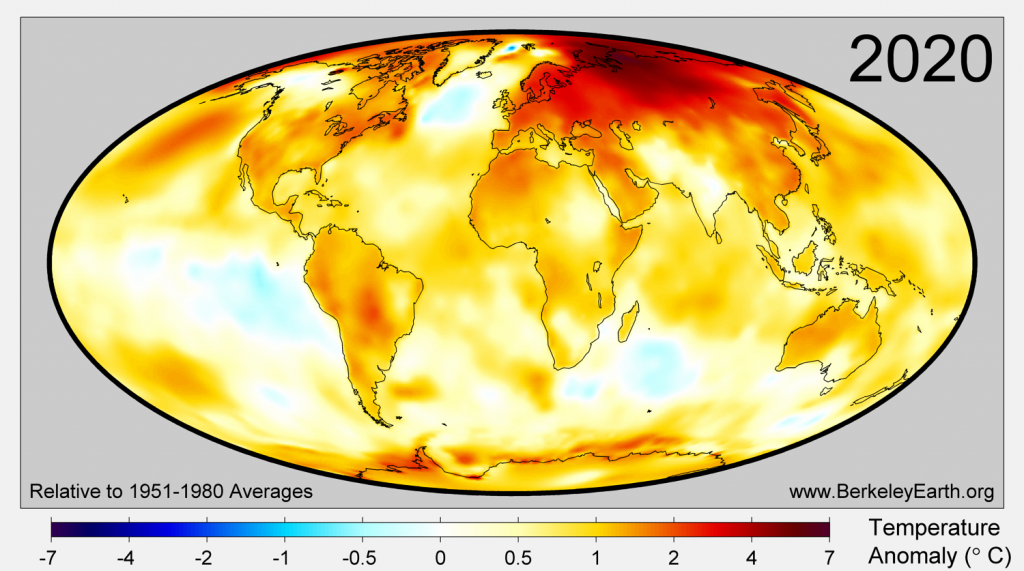In my first article, we have discussed why CO2 emissions are important, current numbers, and estimations for 2021. We have also seen that the increase of greenhouse gases is causing global warming.
Temperature distribution in 2020

Source: Berkeley Earth Global Temperature Report for 2020
Today, I want to tell you about the current global average temperature, why we need to limit it to under 1.5 degrees Celsius (°C), and the potential risks if we go over that threshold. Then, I will explain the “carbon budget”, why we need net-zero emissions targets, and conclude with what we need in terms of international commitments.
The 1.5 degrees Celsius limit
If you have been reading my articles, you know that I like numbers. In this case, the number is 1.5 degrees Celsius.
Let’s explain.
As part of the United Nations and its Framework Convention on Climate Change (UNFCCC), all nations meet each year at the Conference of the Parties (COP).
During the COP21, in 2015, 197 countries adopted the Paris Agreement and agreed to keep the global average temperature well below 2 degrees Celsius (2°C) with efforts to limit the temperature increase to 1.5°C above pre-industrial levels.
Why do we need to keep the temperature increase below 1.5 degrees Celsius above pre-industrial levels?
The Intergovernmental Panel on Climate Change (IPCC) wrote the Special Report: Global Warming at 1.5 Degrees Celsius in 2018 to compare the impacts of climate change at 1.5 versus 2°C. The report explains that a rise in global temperatures of more than 1.5 degrees Celsius would determine higher risks, potentially resulting in more extreme droughts, heatwaves, floods, sea-level rise, loss of biodiversity.
As a result, “climate-related risks to health, livelihoods, food security, water supply, human security, and economic growth are projected to increase.”
So now we know the threshold (1.5°C) and the risks (natural, social, and economic).
What’s the current status?
The global average surface temperature has already increased more than one degree Celsius (see graph below).

The carbon budget
Our next question is: how much more can we add to the atmosphere before the global temperature reaches 1.5 degrees Celsius?
To know this, we need to introduce the concept of “carbon budget” for the whole world. A “carbon budget” estimates the total amount of carbon dioxide we can emit before we hit 1.5°C of warming. Considering the same IPCC special report indicated above, we have a remaining budget of 420 GtCO2 for a 67% chance of limiting warming to 1.5°C, which means that every ton of carbon dioxide counts.
Here the point is that If we continue with the present trajectory (of emissions) we will use our carbon budget very soon.
Net-zero emissions
The next number is zero. Net-zero.
We need to achieve and maintain net-zero global emissions; we have net-zero emissions when the amount of greenhouse gas emissions we put in the atmosphere is the same as the greenhouse gas emissions removed. Of course, we can still produce some emissions, but we need to offset these emissions by taking out greenhouse gases already in the atmosphere.
We can do this starting with nature-based solutions, but we will also need new technologies to remove carbon dioxide from the atmosphere (this means investments).
Now, you might be wondering why I am not saying net-zero by 2050. It’s because it depends on many variables. There are many assumptions under the calculation of carbon budgets in terms of chance, non-CO2 gases, carbon cycle feedbacks, etc.
Therefore we can simplify and say that we need mid-century net-zero targets (it is essential, and the sooner the better), and we must set interim targets aligned with the long-term goal. Globally, this means reducing carbon emissions every year from 2020 (UN Environment Programme (UNEP) Emission gap report).
What do we need? A 45% reduction of our emissions by 2030 (from 2010 levels).
The reality
Current international climate commitments
As part of the Paris agreement, each country was asked to create national climate action plans, formerly called nationally determined contributions (NDCs), and to increase their ambition every five years.
Even if all countries meet their current climate targets, this will not be enough to limit global warming to even two degrees Celsius, let alone 1.5°C. The Climate Action Tracker is tracking these updated targets and net-zero pledges and found these commitments (@ April 2021) have a 78% probability of exceeding the two degrees Celsius, while the current policy pathways have a greater than 97% probability of exceeding 2°C.
Let me be clear.
- Global energy-related CO2 emissions are currently expected to rise (IEA global energy review 2021)
- Global average temperature already +1.1 °C
Paris agreement: limiting warming well below 2°C, efforts to stay under 1.5°C.
- Current commitments: 97% probability of exceeding 2°C
- New commitments (@April 2021): 78% probability of exceeding 2°C.
The next Conference of Parties (COP26) is set to be in Glasgow in November. We know the numbers.
We need more ambitious targets, plans, and mechanisms so that governments are accountable for delivering on their commitments (e.g., legal obligations).
Climate change is a complex topic, and there is no single solution to solve this huge (global and local) challenge. However, I believe that we can act and take responsibility for more sustainable choices every day – as a person or community, business leader, or government. If you would like to know more about my blog visit protegoterra.org.
Thanks for reading!
If you enjoyed this article, subscribe to Protegoterra’s newsletter.

